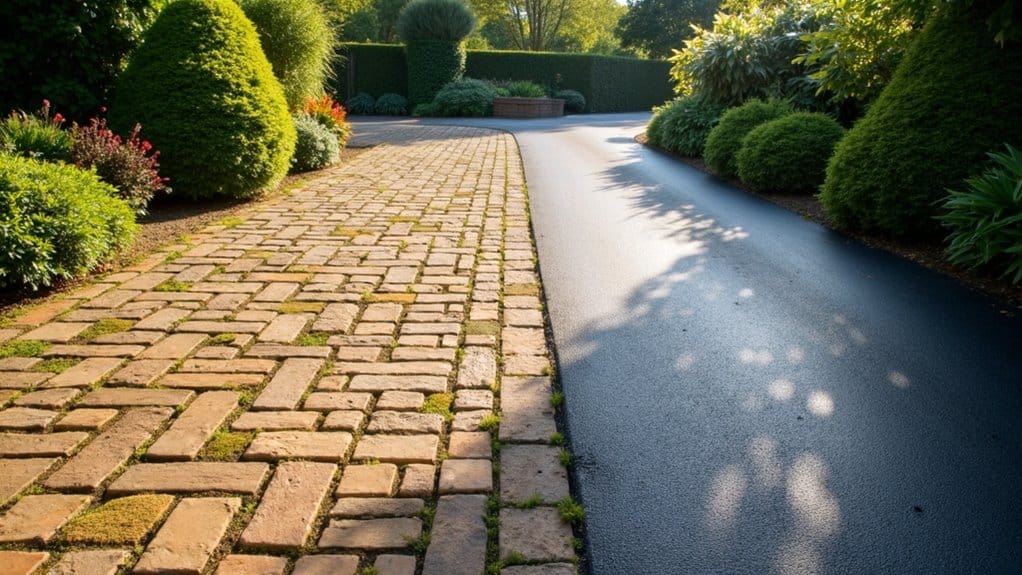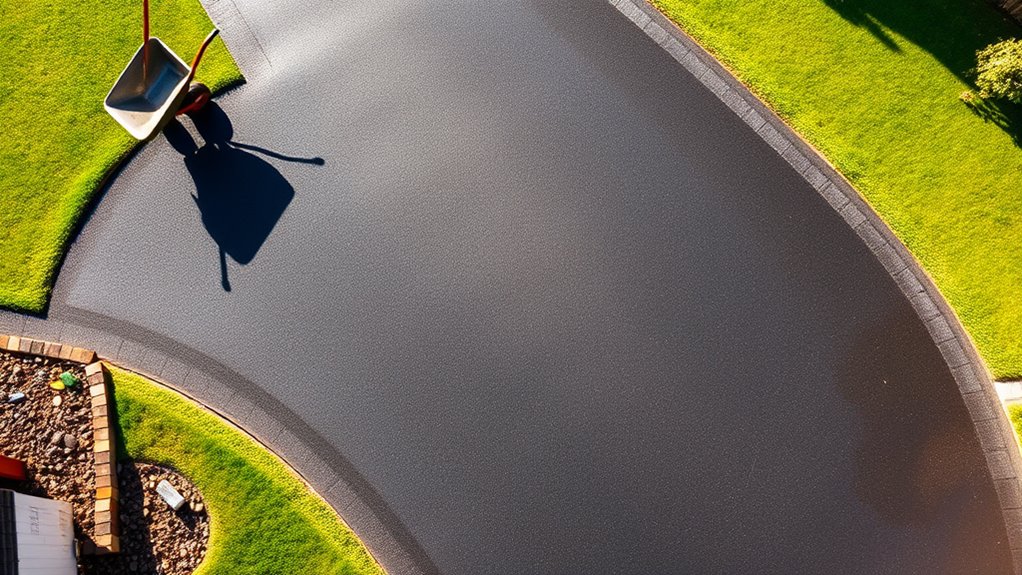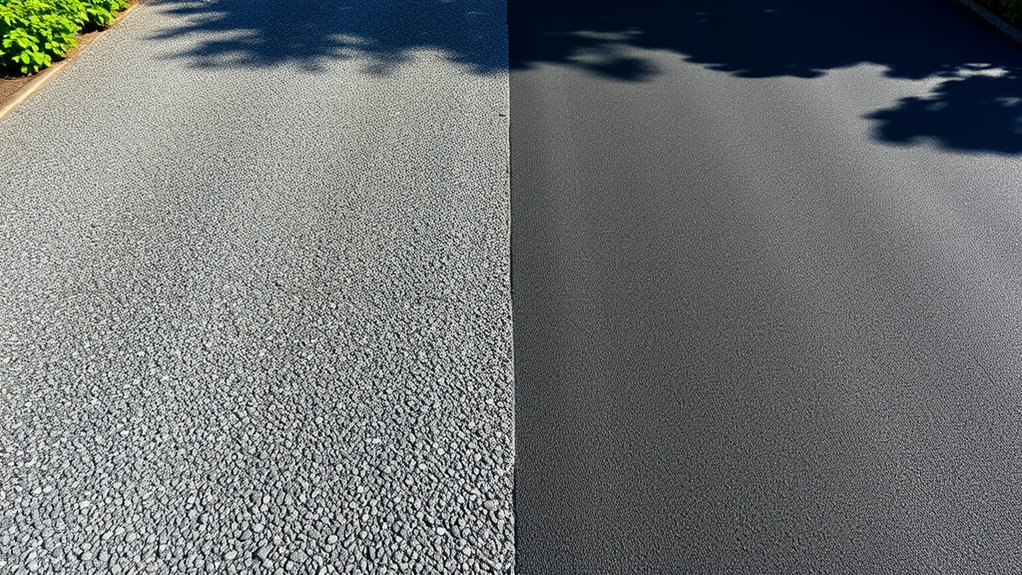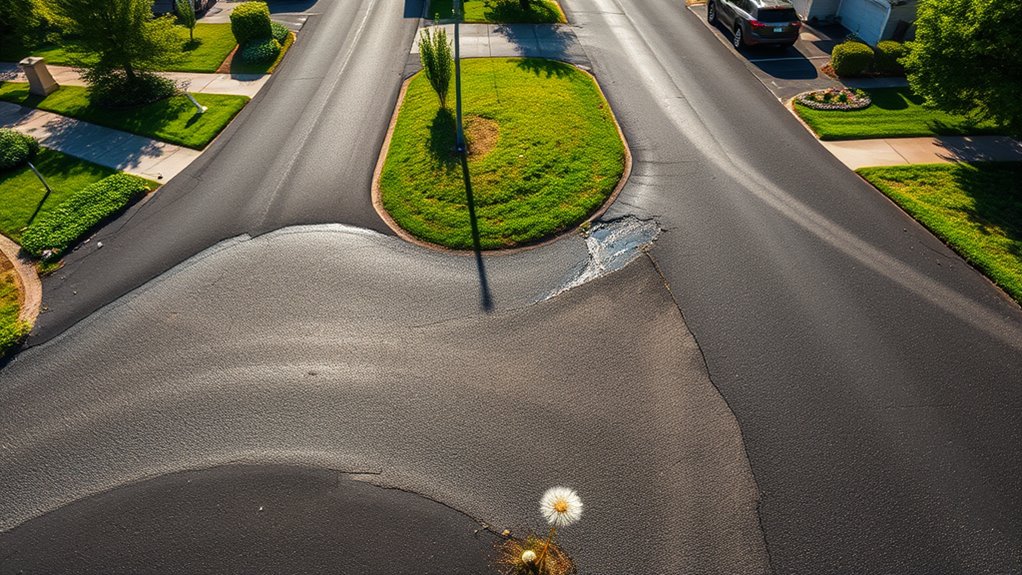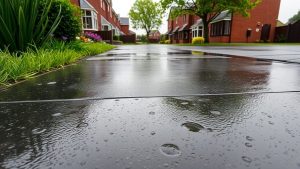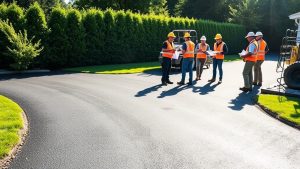When comparing block paving to tarmac driveways, it’s essential to look at costs, durability, and appearance. Block paving generally has a higher initial cost but tends to last longer and offers a wider variety of designs. In contrast, tarmac is more affordable to install but doesn’t last as long and has limited aesthetic appeal.
Maintenance is another factor to consider: block paving requires regular upkeep, such as cleaning and re-sanding, while tarmac needs less frequent attention, primarily occasional resealing. Each option has its advantages and disadvantages, so understanding these aspects will help you decide which is best for your needs.
Table of Contents
ToggleKey Takeaways
- Block paving provides a wide range of design options, with various colours and patterns to choose from, unlike tarmac which offers limited aesthetics.
- For larger areas, tarmac is often more affordable, but block paving delivers better long-term value due to its durability.
- While block paving needs regular maintenance like sealing and weed control, tarmac is easier to look after, requiring just occasional pressure washing.
- Repairs are simpler with block paving since you can replace individual blocks, whereas tarmac usually needs larger patches for fixes.
- With proper care, block paving can last 20-30 years, compared to tarmac’s 10-20 years, which can influence your long-term investment decision.
Cost Comparison
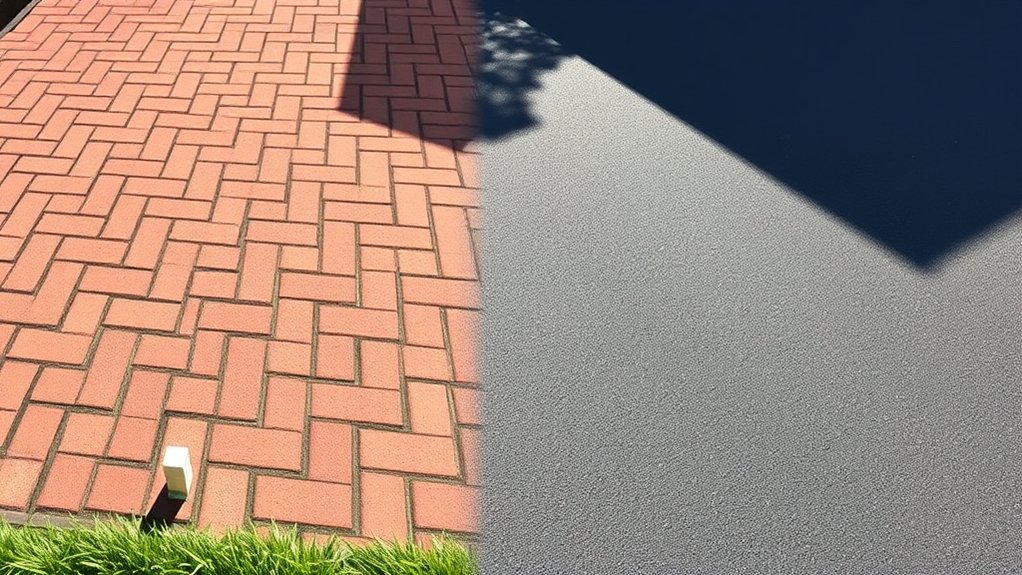
When choosing a driveway, cost is usually the first consideration, and there’s a notable difference between tarmac and block paving.
Tarmac typically costs between £45 and £110 per square metre, making it the more affordable option. On the other hand, block paving materials range from £19 to £48 per square metre, but when you add labour costs—which can match or even exceed the price of materials—your total expenses can increase significantly. Additionally, the complexity of installation can lead to longer setup times for block paving compared to tarmac. Tarmac also requires regular maintenance, such as sealing every few years, which can affect long-term costs.
Installation times also vary; tarmac can often be completed within 1 to 2 days, whereas block paving may take several days due to its detailed design.
Regional pricing can further influence costs, especially in areas like London where both materials and installation tend to be pricier. Understanding these financial aspects is crucial for making an informed choice.
Durability and Longevity
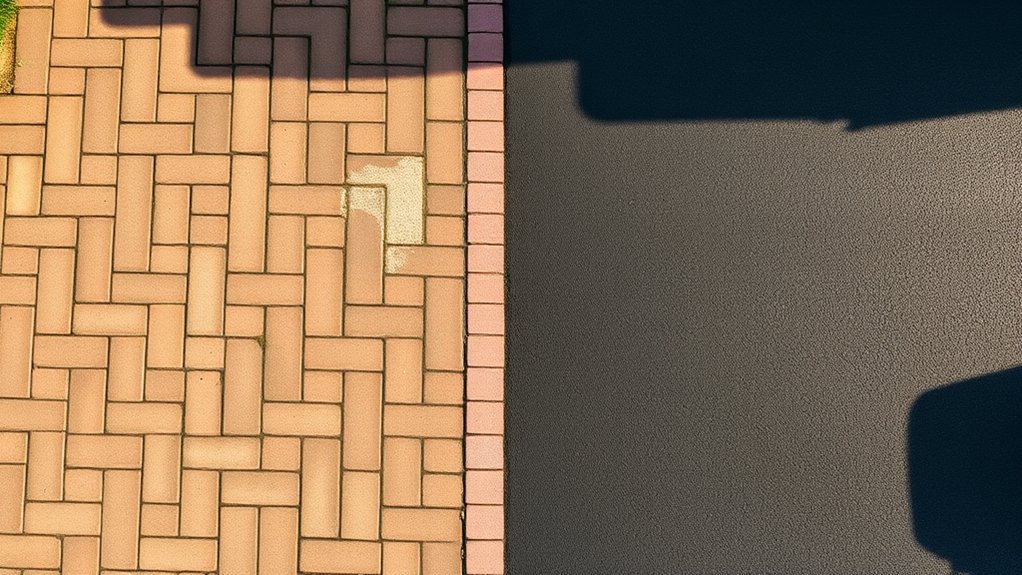
Both tarmac and block paving provide durable options for driveways, but they differ significantly in terms of longevity and resilience. Block paving generally lasts between 20 to 30 years with proper maintenance, whereas tarmac typically endures for about 10 to 20 years. The methods used for installation and the materials involved play a key role in their lifespan. One of the advantages of block paving is the ability to carry out localised repairs. If a single block becomes damaged, it can be replaced without the need to resurface the entire driveway. In contrast, tarmac repairs often require larger patches to maintain a continuous surface. This flexibility makes block paving more resilient, especially in areas prone to ground movement. Additionally, the correct installation can significantly enhance the longevity of both surfaces. Regular upkeep on tarmac is essential to prevent higher repair costs in the future, which can affect its lifespan.
Here’s a quick comparison of their durability:
| Feature | Tarmac |
|---|---|
| Lifespan | 10-20 years |
| Repair Options | Larger patches needed |
| Weather Resistance | Good, but may crack |
| Flexibility | Less adaptable |
Aesthetic Appeal and Versatility
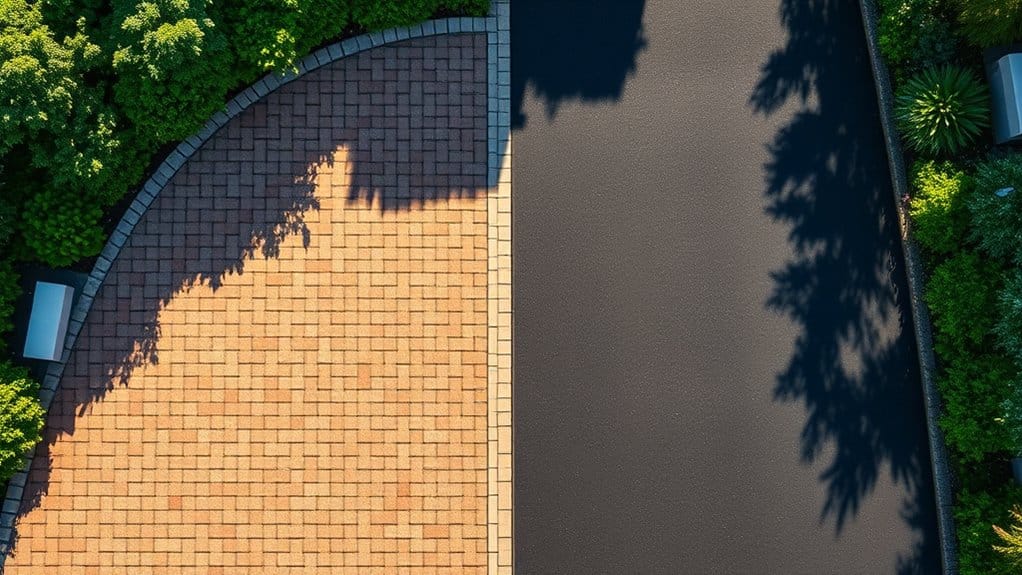
When choosing a driveway, durability is key, but aesthetic appeal and versatility are equally important.
Block paving is a top choice due to its wide range of colours and designs, allowing you to create a layout that suits your home’s style. You can combine different shapes and colours to follow current design trends, boosting your property’s kerb appeal with unique patterns and textures. Additionally, resin surfaces can mimic natural stone, providing a more attractive option for homeowners looking for versatility.
In contrast, tarmac offers limited colour options, resulting in a more uniform, industrial appearance. The textured surfaces of block paving can blend seamlessly with your landscaping, adding a warm, inviting touch that complements various property styles. Additionally, block paving’s durability is enhanced through targeted repairs, making it a wise investment for homeowners.
Ultimately, your choice won’t only affect functionality but also define the character of your outdoor space.
Maintenance Requirements
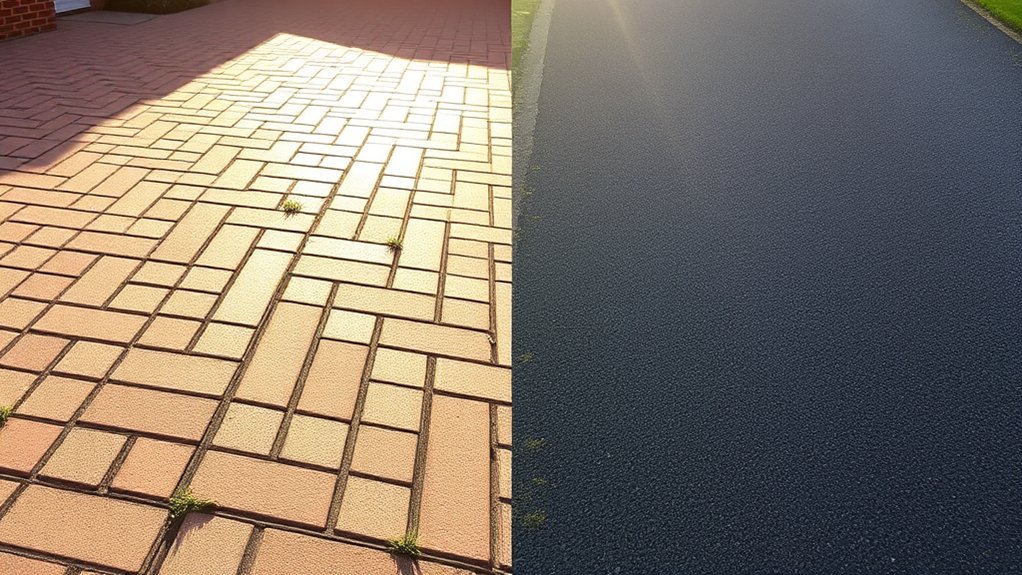
When it comes to maintenance, tarmac driveways are easier to manage. They require less frequent cleaning and repairs are straightforward.
On the other hand, block paving needs more upkeep. You’ll have to regularly clean it, seal the blocks, and control weeds to keep it looking good.
Knowing these differences can help you choose what fits best with your lifestyle and preferences.
Tarmac Maintenance Advantages
To ensure your tarmac driveway remains durable and long-lasting, regular maintenance is crucial. Simple practices can significantly extend its lifespan.
Begin by sweeping regularly to remove debris that can damage the surface. An annual pressure wash will tackle stubborn dirt, while a mild detergent will keep it looking fresh.
Routine cleaning also allows you to spot cracks early, enabling prompt repairs and preventing costly damage. Applying a sealcoat every 3 to 5 years protects against UV rays and water damage, offering substantial longevity benefits.
Don’t forget to remove weeds; their roots can compromise the tarmac. By following these straightforward tips, you’ll keep your driveway resilient and looking good for years to come.
Block Paving Care Needs
Maintaining block paving is essential for its longevity and visual appeal. Begin with regular cleaning using a stiff-bristled broom to remove debris and prevent stains. Avoid power washing initially; instead, focus on spot cleaning to protect the settled blocks.
For a deeper clean, consider using professional cleaning products and ensure you rinse thoroughly afterwards.
Joint sand maintenance is vital too. Check and replenish joint sand regularly to keep the blocks stable and to deter weeds. When necessary, opt for polymeric sand for the best results.
Regularly inspect your paving for any damage or displacement and address these issues promptly to maintain safety and aesthetics.
Lastly, think about applying a sealant from time to time to guard against stains and boost curb appeal, keeping your block paving in top condition.
Weather Performance
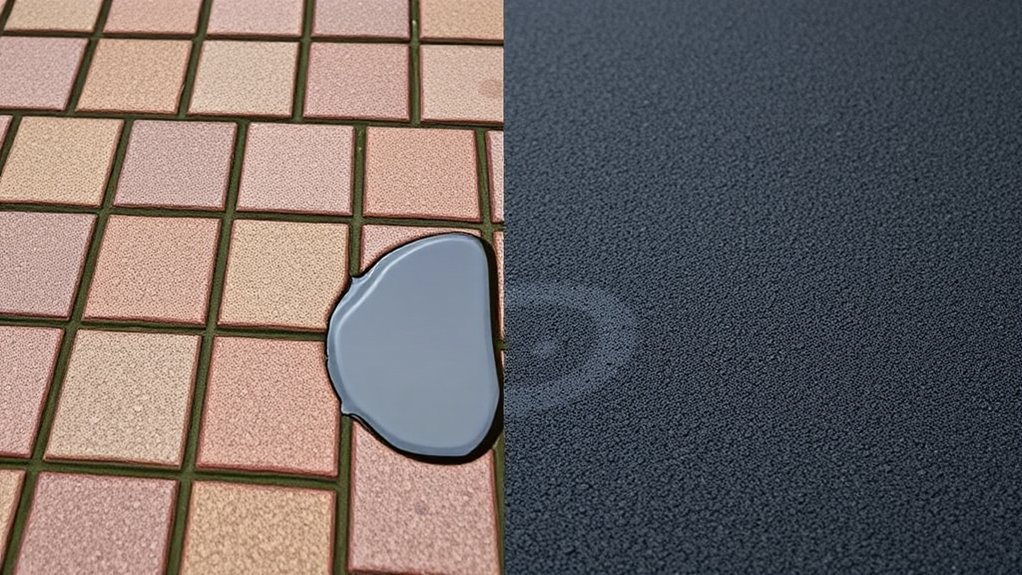
When it comes to weather performance, tarmac driveways are superior in handling temperature changes, easily withstanding freeze-thaw cycles without cracking.
On the other hand, block paving can shift under similar conditions, which raises stability concerns.
Tarmac also boasts a smooth surface that allows for efficient drainage, whereas block paving’s permeability requires regular maintenance to avoid erosion and standing water.
Temperature Resistance Comparison
When comparing block paving and tarmac driveways, their performance in extreme temperatures highlights some key differences. Tarmac tends to soften and crack in high heat, which can significantly reduce its lifespan. In contrast, block paving offers excellent heat resistance, remaining stable and durable even in warmer climates.
| Feature | Block Paving | Tarmac |
|---|---|---|
| Heat Resistance | Excellent (withstands high temps) | Poor (softens in heat) |
| Lifespan | Around 25 years | Typically 12-20 years |
| Cold Weather Performance | Flexible with joints | Prone to cracking |
| Maintenance Frequency | Needs sealing | Requires less frequent care |
Drainage Efficiency Analysis
Effective drainage is crucial for the durability and usability of driveways, particularly in poor weather. Block paving stands out for its drainage capability, as its permeable surfaces allow water to seep through the joints. This reduces surface runoff and lowers the risk of flooding, helping to replenish groundwater during heavy rain.
However, it’s essential to ensure proper installation and regular maintenance to maintain this permeability.
In contrast, tarmac driveways are usually impermeable, which can lead to increased surface runoff and potential pooling during heavy rain, unless additional drainage solutions are implemented. The effectiveness of tarmac’s drainage largely depends on careful grading and any built-in drainage features.
Ultimately, while block paving provides better drainage efficiency, both materials need diligent upkeep to perform well in adverse weather conditions.
Environmental Considerations
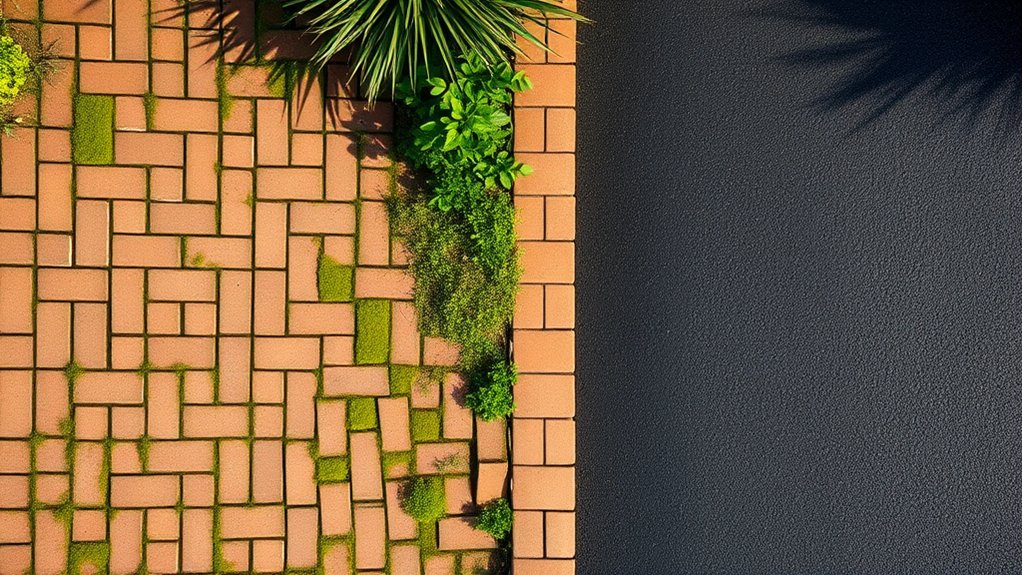
With environmental sustainability becoming increasingly important, it’s crucial to assess the ecological effects of paving materials like block paving and tarmac driveways.
While tarmac is cheaper, its production is energy-intensive, leading to high carbon emissions and habitat disruption. On the other hand, block paving usually requires less energy and can incorporate recycled materials, making it a more sustainable choice.
Block paving can also be designed to be permeable, which helps manage water more effectively and reduces runoff—unlike the impermeable nature of tarmac. This permeability not only minimises environmental harm but also promotes groundwater recharge and supports local ecosystems.
Furthermore, block paving is easier to recycle, which helps reduce landfill waste, a key aspect of sustainability and lowering the ecological footprint of your driveway.
Long-Term Value
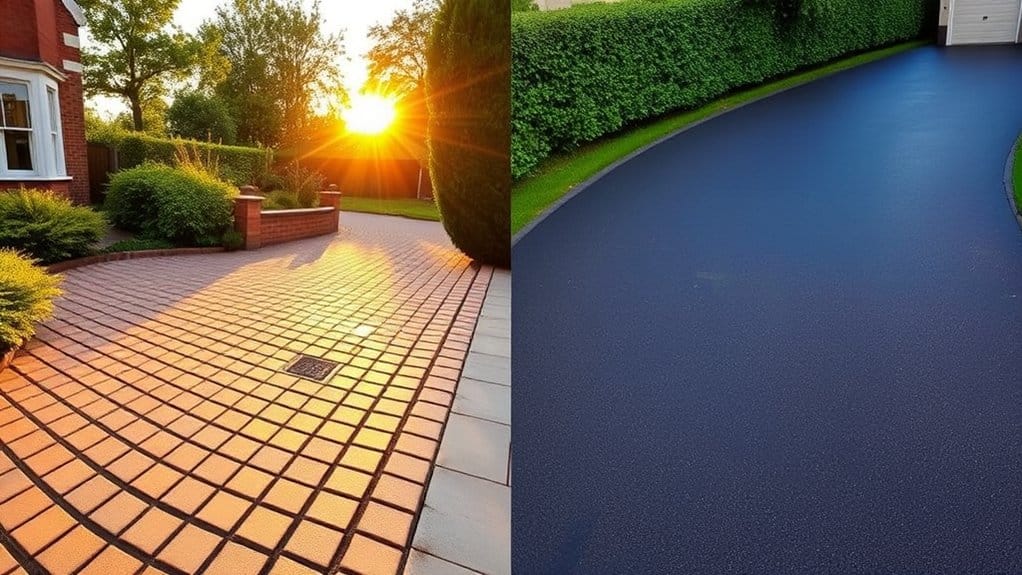
When assessing long-term value, block paving and tarmac driveways each have their own advantages and drawbacks that influence your investment. Block paving tends to have a higher initial cost, but its durability and ease of repair can offer better returns over time. In contrast, tarmac has lower upfront costs but may not significantly boost your property’s value in the long run.
| Feature | Block Paving | Tarmac |
|---|---|---|
| Lifespan | 20-25 years | 15-20 years |
| Maintenance Frequency | High (requires sealing and weed control) | Low (occasional resurfacing) |
| Repair Flexibility | High (individual blocks can be replaced) | Low (larger sections need repair) |
| Initial Cost | Higher (£10-£40/sq ft) | Lower (£70-£110/sq m) |
Suitability for Different Needs
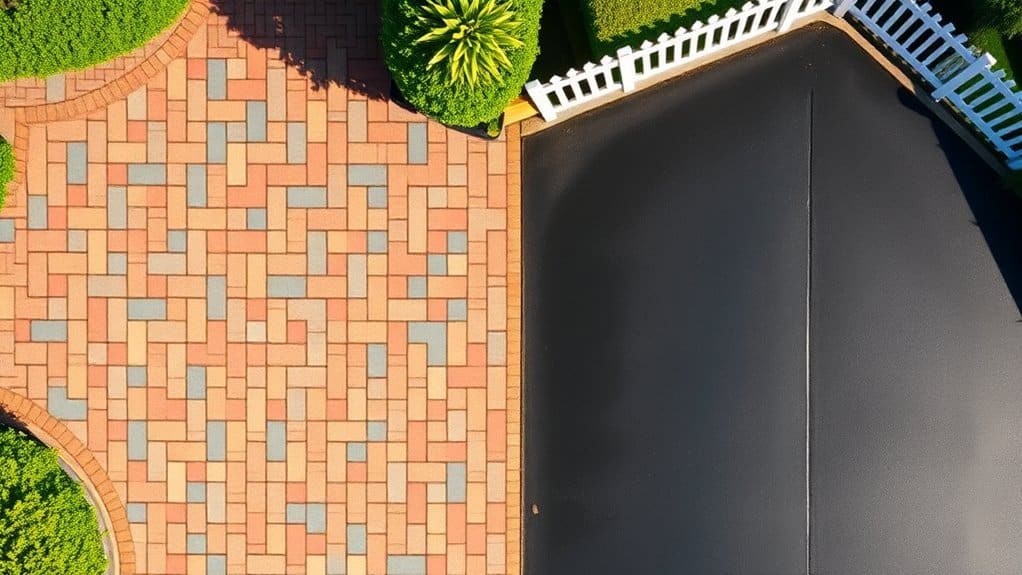
Choosing between block paving and tarmac driveways depends on your needs, preferences, and budget.
If design is important to you, block paving offers a wide range of colours, patterns, and finishes that can enhance your home’s appeal. However, if you’re on a budget, tarmac is a more cost-effective option, especially for larger areas, due to its lower installation costs.
In terms of usage, tarmac provides a sleek, modern look and is durable, making it suitable for households with several vehicles.
On the other hand, block paving is known for its longevity and ease of repair, adapting well to various weather conditions.
Ultimately, your decision should balance your aesthetic preferences with practical needs.
Final Thoughts on Choosing Between Options
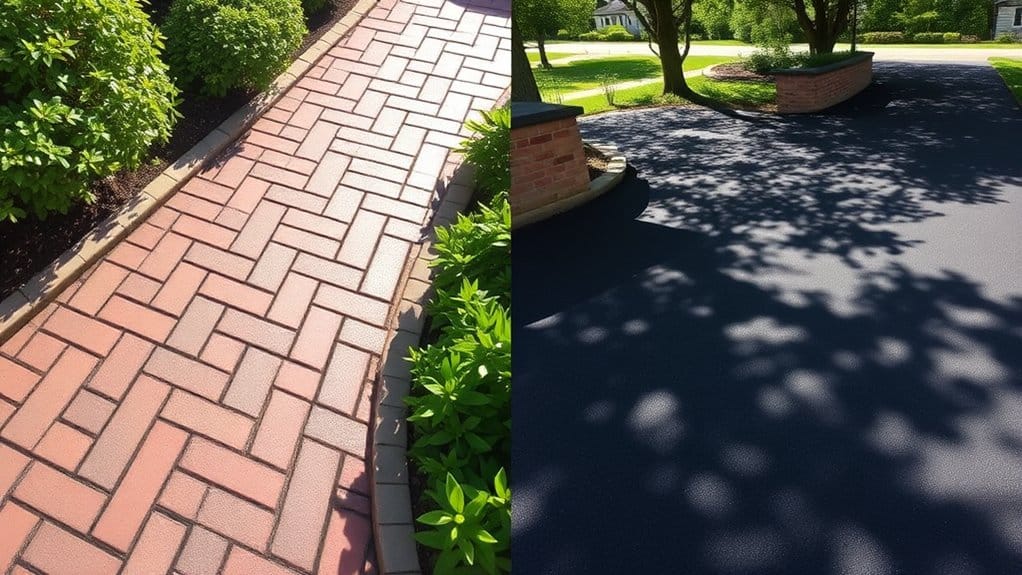
Choosing between block paving and tarmac driveways ultimately depends on your individual needs and preferences. Think about how you’ll use your driveway, how quickly you want it installed, and the look you’re after.
Block paving stands out with its appealing design and durability, but it takes longer to install and requires more upkeep. On the other hand, tarmac is a budget-friendly and quick option with minimal maintenance but offers limited design choices.
| Factor | Block Paving | Tarmac |
|---|---|---|
| Installation Time | Takes longer | Installed quickly |
| Aesthetic Appeal | Versatile designs | Fewer options |
| Maintenance | Needs regular upkeep | Low maintenance |
| Durability | Long-lasting | Generally shorter lifespan |
| Repairability | Easy to replace individual blocks | More challenging to repair |
Weigh these factors to find the best fit for your property.
Frequently Asked Questions
How Long Does the Installation Process Take for Each Option?
The installation time can vary significantly; block paving usually takes between 4 to 7 days, while tarmac can be completed in just 1 to 3 days. Factors such as the size of the area and design complexity can affect these timeframes. For example, a straightforward driveway may be quicker to install than an elaborate patio.
Can I Install Block Paving or Tarmac Myself?
If you’re thinking about installing block paving or tarmac yourself, be aware that it requires both skill and considerable time. Block paving can be manageable for DIY enthusiasts, but tarmac is more difficult and often needs specialised equipment. Consider whether the effort is worth it compared to hiring professionals, as they can ensure a better finish and safety.
What Colors Are Available for Tarmac Driveways?
Tarmac driveways come in a variety of colours, from classic grey to vibrant reds and greens, as well as other unique shades. If installed and maintained properly, these colours can remain durable, ensuring your driveway retains its visual appeal over time.
Are There Different Grades of Tarmac Available?
Did you know tarmac driveways can last between 15 to 30 years? There are various grades of tarmac, such as base and surface courses, each tailored for specific uses. This helps improve durability, especially considering factors like traffic load and local weather conditions. For instance, a thicker base course is ideal for heavy traffic areas, while a smoother surface course is perfect for residential driveways.
How Do Extreme Temperatures Affect Each Material?
Extreme temperatures significantly affect material durability. Block paving is resilient, withstanding freeze-thaw cycles with little damage. In contrast, tarmac tends to soften or crack in high heat, which can shorten its lifespan and compromise its structural integrity in tough conditions.
Conclusion
When comparing block paving and tarmac driveways, think of each as a unique option for your outdoor space. Block paving provides a beautiful, durable finish with a variety of styles, while tarmac is a smooth, cost-effective choice. Your decision should reflect your priorities—whether you prefer the charm of individual bricks or the practical nature of asphalt. Consider how each material will hold up over time and fit your personal style, ensuring your driveway makes a great first impression.
How can a tarmac driveway enhance your home's appeal? Discover the key aspects of cost, installation, and maintenance in our Read more
Beneath the surface of tarmac and asphalt driveways lies a world of differences; discover which option suits your needs best.
Uncover the hidden environmental costs of tarmac driveways and explore whether they truly align with sustainable living—what alternatives could be Read more

